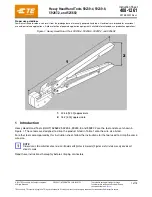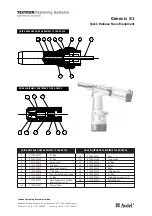
Instruction Manual IM‐293
CUSTOMER'S INFORMATION BOX
CONTENTS ARE INDEPENDENT OF RIVERHAWK DOCUMENT CONTROL
215 Clinton Road
New Hartford, NY 13413
Tel: +1 315 768 4855
Fax: +1 315 768 4941
Email: [email protected]
REV
373A4058
GE DRAWING NUMBER
Revision F
Page 9 of 21
Illustration 6
Slide the gland nut down over the collar. (See
Illustration 6) Insert the 3/8” tube or 3/8” hose
end into tensioner or hydraulic pump. While firmly
holding the tube or hose end to stop it from
rotating, turn the gland nut clockwise (
right hand
thread) and torque the gland nut to 50 FT‐LBS (68
N‐m).
Tips:
Make sure all parts are clean and free from
debris.
Protect the cone on the end of the 3/8” tube
or 3/8” hose end from scratches as this is the
sealing surface.
Replace red plastic caps when finished to
protect the threads and cone.
4.3 Check Hydraulic Port in the Pump and Tensioner
Before connecting the hydraulic hose to the pump or tensioner, check the hydraulic port for
grit, dirt, and other debris. Clean with a brush and, if necessary, with a volatile solvent such as
acetone. Do not force the debris deeper into the port.
4.4 Check Hydraulic Tensioner
Refer to the hydraulic tensioner instruction manual for inspection procedure.
5.0 Operation
5.1 Manual Pump Operation
The figures 1 and 2 at the end of this manual depict the location of the components used to
operate the manual pump kits.
Step #1: Connect the pump to the tensioner with the appropriate hydraulic hose and open the
release knob.
WARNING
Check the maximum working pressures of the hoses and tensioners connected to the pump. Do
not exceed the maximum working pressure of the pump, hose, or tensioner.







































